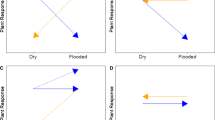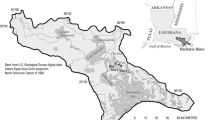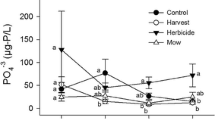Abstract
Despite their central role in lakeshore restoration, most littoral wetland plantings fail. The reasons for these failures are poorly understood, in part due to limited information on the effects of planting time, water depth, and propagation on the survival of emergent macrophyte plantings. We planted pots and prevegetated mats of softstem bulrush (Schoenoplectus tabernaemontani (C.C. Gmel.) Palla) at two different water depths (0–30 and 31–60 cm) in five lakes each month between May and September 2006 to evaluate the effects of planting month, water depth, and transplant type on the survival of planted S. tabernaemontani. Overall survival decreased from 73% at 30 days after planting to 40% pre-winter to 15% post-winter. The timing of planting was the most important factor influencing bulrush survival. Survival of bulrush planted later in the growing season is poor, regardless of the transplant type used, and should be avoided. During the optimal planting season of early-to-mid summer, transplants from pots are more likely to outperform mats, despite lower pre-planting biomass. Water depth is only important immediately after planting, after which time, its influence on successful establishment diminishes. Overall, our research indicated that key choices made by the practitioner can improve the likelihood that transplants establish in littoral wetland restorations.




Similar content being viewed by others
References
Bernard JM (1975) The life history of shoots of Carex lacustris. Can J Bot 53:256–260
Bernard JM (1990) Life-history and vegetative reproduction in Carex. Can J Bot 68:1441–1448
Bernard JM, Solsky BA (1977) Nutrient cycling in a Carex lacustris wetland. Can J Bot 55:630–638
Bryan MD, Scarnecchia DL (1992) Species richness, composition, and abundance of fish larvae and juveniles inhabiting natural and developed shorelines of a glacial Iowa lake. Environ Biol Fishes 35:329–341
Budelsky RA, Galatowitsch SM (2000) Effects of water regime and competition on the establishment of a native sedge in a restored wetlands. J Appl Ecol 37:971–985
Budelsky RA, Galatowitsch SM (2004) Establishment of Carex stricta Lam. seedlings in experimental wetlands with implications for restoration. Plant Ecol 175:91–105
Christensen DL, Herwig BR, Schindler DE, Carpenter SR (1996) Impacts of lakeshore residential development on coarse woody debris in north temperate lakes. Ecol Appl 6:1143–1149
Crowder AA, Smol JP, Dalrymple R, Gilbert R, Mathers A, Price J (1996) Rates of natural and anthropogenic change in shorelines habitats in the Kingston Basin, Lake Ontario. Can J Fish Aquat Sci 55(Suppl 1):121–135
Dabbs DL (1971) A study of Scirpus acutus and Scirpus validus in Saskatchewan River Delta. Can J Bot 49:143–153
Davies A, Dunnett NP, Kendle T (1999) Transplant size and gap width in the botanical enrichment of species-poor grasslands in Britain. Restor Ecol 7:271–280
De Szalay FA, Cassidy W (2001) Effects of muskrat (Ondatra zibethicus) lodge construction on invertebrate communities in a Great Lakes coastal wetland. Am Midl Nat 146:300–310
Dick GO, Smart RM, Snow JR (2004) Aquatic vegetation restoration in Drakes Creek, Tennessee. Aquatic plant control research program bulletin, vol A-04-1
Elias JE, Meyer MW (2003) Comparisons of undeveloped and developed lakeshores, northern Wisconsin, and recommendations for restoration. Wetlands 23:800–816
Errington PL (1963) Muskrat populations. Iowa State University Press, Ames, 665 pp
Gallagher JL, Wolf PL, Pfeiffer WJ (1984) Rhizome and root growth rates and cycles in protein and carbohydrate concentrations in Georgia Spartina alternifolia Loisel. Am J Bot 71:165–169
Harris SW, Marshall WH (1963) Ecology of water level manipulation on a northern marsh. Ecology 44:331–343
Henderson CL, Dindorf CJ, Rozumalski FJ (1999) Lakescaping for wildlife and water quality. Minnesota Department of Natural Resources, Nongame Wildlife Program, Section of Wildlife, St. Paul
Jennings MJ, Bozek MA, Hatzenbeler GR, Emmons EE, Staggs MD (1999) Cumulative effects of incremental shoreline habitat modification on fish assemblages in north temperate lakes. N Am J Fish Manag 19:18–27
Kadlec JA, Wentz WA (1974) State-of-the-art survey and evaluation of marsh plant establishment techniques: indirect and natural. Vol 1 Report of research. AD-AOIZ 834. Army Engineer Waterways Experiment Station Coastal Engineering Research Centre. National Technical Information Service, U.S. Department of Commerce, Washington, DC
Lieffers VJ, Shay JM (1981) The effects of water level on the growth and reproduction of Scirpus maritimus var. paludosus. Can J Bot 59:118–121
Macaulay AJ (1973) Taxonomic and ecological relationships of Scirpus acutus Muhl. and S. validus Vahl. (Cyperaceae) in southern Manitoba. Dissertation, University of Manitoba
National Research Council (1992) Restoration of aquatic ecosystems: science, technology, and public policy. National Academy Press, Washington, DC
Page HN, Bork EW (2005) Effect of planting season, bunchgrass species, and neighbor control on the success of transplants for grassland restoration. Restor Ecol 13:651–658
Radomski P (2006) Historical changes in abundance of floating-leaf and emergent vegetation in Minnesota lakes. N Am J Fish Manag 26:932–940
Radomski P, Goeman TJ (2001) Consequences of human lakeshore development on emergent and floating-leaf vegetation abundance. N Am J Fish Manag 21:46–61
Reinelt L, Horner R, Azous A (1998) Impacts of urbanization on palustrine (depressional freshwater) wetlands—research and management in the Puget Sound region. Urban Ecosyst 2:219–236
Roseff SJ, Bernard JM (1979) Seasonal changes in carbohydrate levels in tissues of Carex lacustris. Can J Bot 57:2140–2144
Shay JM, Shay CT (1986) Prairie marshes in western Canada, with specific reference to the ecology of five emergent macrophytes. Can J Bot 64:443–454
Shipley B, Keddy PA, Lefkovitch LP (1991) Mechanisms producing plant zonation along a water depth gradient—a comparison with the exposure gradient. Can J Bot 69:1420–1424
Steed JE, DeWald LE (2003) Transplanting sedges (Carex spp.) in southwestern riparian meadows. Restor Ecol 11:247–256
Vanderbosch D, Galatowitsch S (2010) An assessment of lakeshore restorations in the Minneapolis/St. Paul Metropolitan Area. Ecol Restor 28:71–80
Walker JM (1965) Vegetation changes with falling water levels in the Delta Marsh, Manitoba. Dissertation, University of Manitoba
Weller MW (1994) Freshwater marshes: ecology and management, 3rd edn. University of Minnesota Press, Minneapolis
Welling CH, Pederson RL, van der Valk AG (1988) Recruitment from the seed bank and the development of zonation of emergent vegetation during a drawdown. J Ecol 76:483–496
Wilcox DA, Meeker JE (1991) Disturbance effects on aquatic vegetation in regulated and unregulated lakes in northern Minnesota. Can J Bot 69:1542–1551
Wilcox DA, Meeker JE (1992) Implications for faunal habitat related to altered macrophyte structure in regulated lakes in northern Minnesota. Wetlands 12:192–203
Wilson SD, Keddy PA (1988) Species richness, survivorship, and biomass accumulation along an environmental gradient. Oikos 53:375–380
Wilson SD, Moore DR, Keddy PA (1993) Relationships of marsh seedbanks to vegetation patterns along environmental gradients. Freshw Biol 29:361–370
Witje AH, Gallagher JL (1991) The importance of dead and young live shoots of Spartina alternifolia (Poaceae) in a mid-latitude salt marsh for over-wintering and recoverability of underground reserves. Bot Gaz 152:509–513
Yetka LA, Galatowitsch SM (1999) Factors affecting revegetation of Carex lacustris and Carex stricta from rhizomes. Restor Ecol 7:162–191
Acknowledgments
Funding for this project was provided by the Minnesota Department of Natural Resources and the U.S. Geological Survey. We would like to thank John Hiebert, Neil Vanderbosch, and Bill Bartodziej for their invaluable support, and unique insights that contributed to the design of the project. Many thanks also to Derrin Eaton, Ross Banswarth, Joel Stiras, Tim Ohlman, Basil Iannone, and Jennifer Doriott, who provided field assistance. Dr. Sanford Weisberg, Aaron Rendahl and Sai Okabayashi, U of M Department of Statistics, assisted with data analysis. Bruce Vondracek, Ray Newman, Rachel Budelsky, and two anonymous reviewers provided helpful comments that improved the manuscript.
Author information
Authors and Affiliations
Corresponding author
Rights and permissions
About this article
Cite this article
Vanderbosch, D.A., Galatowitsch, S.M. Factors affecting the establishment of Schoenoplectus tabernaemontani (C.C. Gmel.) Palla in urban lakeshore restorations. Wetlands Ecol Manage 19, 35–45 (2011). https://doi.org/10.1007/s11273-010-9198-7
Received:
Accepted:
Published:
Issue Date:
DOI: https://doi.org/10.1007/s11273-010-9198-7




